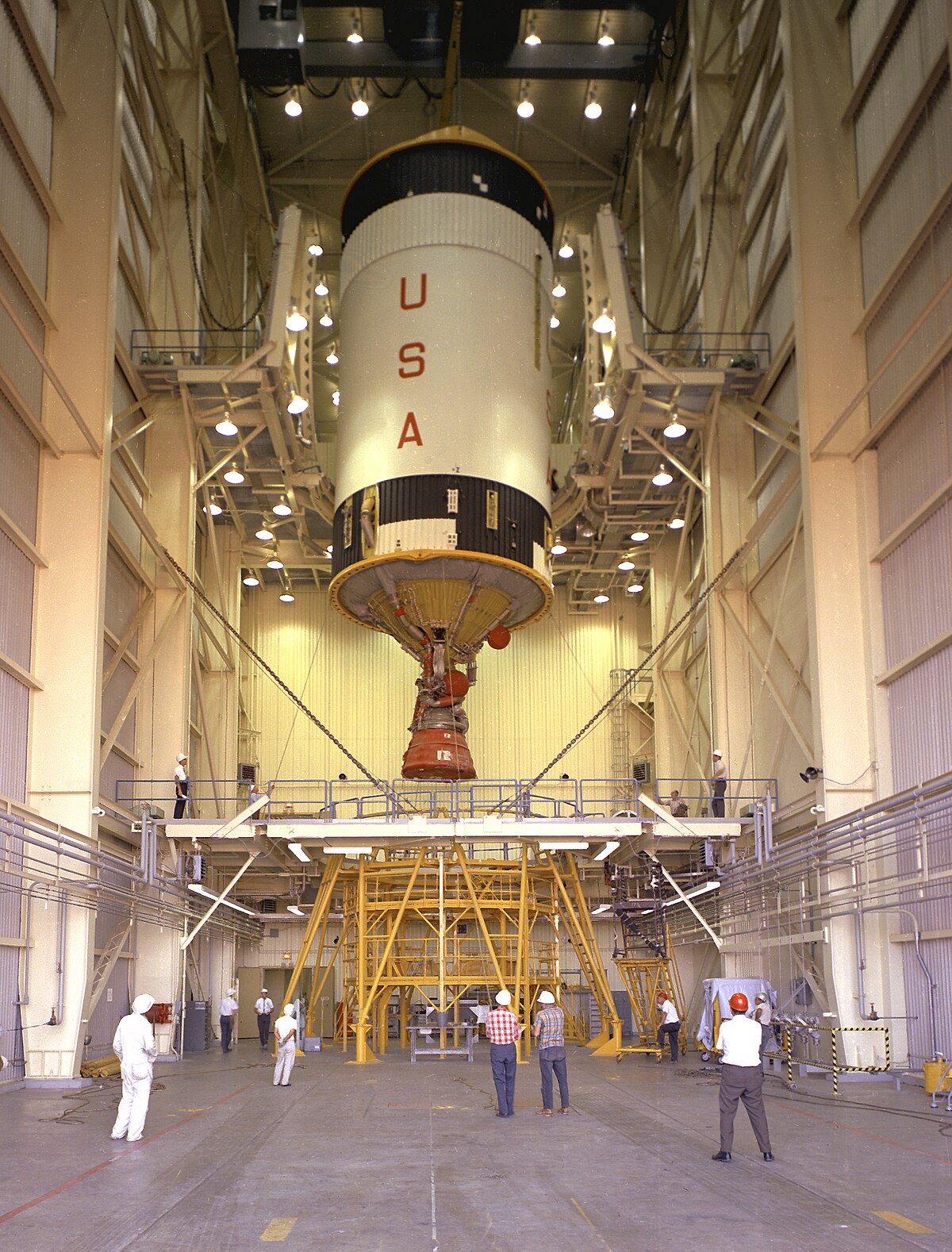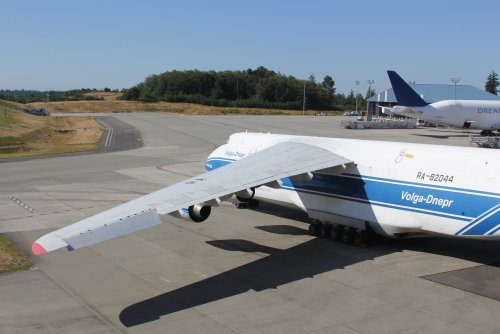An-225 is 290 ft in span, Roc is 385 ft. An-225 span is close enough from civilian airliners max (a bit more than A380), Roc is way, way, way above. not sure airports can handle such a span. Depends were is the plane parked. Standing on a runway, that big span is not a big nuisance. It's manoeuvering near other aircrafts, or near terminals, that is trickier...
You are using an out of date browser. It may not display this or other websites correctly.
You should upgrade or use an alternative browser.
You should upgrade or use an alternative browser.
Stratolaunch
- Thread starter Creative
- Start date
- Status
- Not open for further replies.
The new runway (17L/35R) at YYC could, I'm referring to the wheel track width though ---
The whole runway is more geared to the future cargo aprons which will be accessed directly to the east of the runway, and cargo aircraft wouldn't go anywhere near the terminal.
This photo shows there wouldn't be any problems at all, the YYC runway has the same width but is 1500 ft longer
The whole runway is more geared to the future cargo aprons which will be accessed directly to the east of the runway, and cargo aircraft wouldn't go anywhere near the terminal.
This photo shows there wouldn't be any problems at all, the YYC runway has the same width but is 1500 ft longer
Attachments
- Joined
- 25 June 2014
- Messages
- 1,564
- Reaction score
- 1,453
There probably are a number of runways that the Roc could use, but with a span considerably larger than the 290 ft of the Antonov, it will have fewer options. The number of companies wanting to air-freight superheavy stuff from one to another will be smaller still. The Antonov is already under-utilised, Roc stands almost no chance.
The Antonov's were mostly used moving equipment in the petroleum industry, skid or modules which were heading to eastern Europe and such. They usually couldn't do it direct because they had to run on low fuel and then make a number of stops along the way. If this Roc can lift a decent weight and have the range it might find some use.
Just a quick query, why is it called a Roc, I couldn't find a reference ---
Just a quick query, why is it called a Roc, I couldn't find a reference ---
zebedee
ACCESS: Secret
The Roc was a mythical bird from the Middle East that would carry and feed on baby elephants... 

 mythology.net
mythology.net
Zeb

Roc - Mythical Bird in Middle Eastern | Mythology.net
The Roc is a huge mythical bird most widely known for its ability to pick up and feed on baby elephants. Legend has it that this monstrous creature would also pick up and feed on humans;
 mythology.net
mythology.net
Zeb
- Joined
- 26 September 2008
- Messages
- 1,925
- Reaction score
- 625
Harder to turn than any other aircraft (look at the gear footprint). Harder to park. A one-off aircraft, meaning more expensive to maintain. So limited places it can operate to/from, and a lot of cost.
No way it is going to find use as a transport.
They're going to fly this once, set a record, and retire it.
No way it is going to find use as a transport.
They're going to fly this once, set a record, and retire it.
- Joined
- 25 June 2014
- Messages
- 1,564
- Reaction score
- 1,453
kitnut617 said:The Antonov's were mostly used moving equipment in the petroleum industry, skid or modules which were heading to eastern Europe and such. They usually couldn't do it direct because they had to run on low fuel and then make a number of stops along the way. If this Roc can lift a decent weight and have the range it might find some use.
Just a quick query, why is it called a Roc, I couldn't find a reference ---
"The Antonov" singular refers to the AN-225 "Mriya" already discussed, of which only one was built. "The Antonovs" plural evidently refers to an unstated design or designs built in larger numbers, all candidates for which were significantly smaller than the AN-225 "Mriya". What such relative small fry found a market for is neither here nor there.
The Stratolaunch machine has been widely nicknamed the "Roc". Websites such as Wikipedia, Global Security and Popular Mechanics all note the fact. Presumably it is unofficial, as I have not noticed it on the Stratolaunch website.
steelpillow said:"The Antonov" singular refers to the AN-225 "Mriya" already discussed, of which only one was built. "The Antonovs" plural evidently refers to an unstated design or designs built in larger numbers, all candidates for which were significantly smaller than the AN-225 "Mriya". What such relative small fry found a market for is neither here nor there.
When I was referring to 'Antonovs', it's because both the An-124 and the An-225 come fairly regularly to Calgary, the An-124s more so.
- Joined
- 25 June 2014
- Messages
- 1,564
- Reaction score
- 1,453
kitnut617 said:When I was referring to 'Antonovs', it's because both the An-124 and the An-225 come fairly regularly to Calgary, the An-124s more so.
Oh, I see. Thanks for the clarification.
As a matter of interest, how busy do they keep the An-225? If headline news were anything to go by, it would seem to be near-permanently absent from the skies.
In the four years I worked at the airport, it came three times and I saw it one of those times. Usually it was for a pre-fab skid/module in the petro industry. The An-124 on the other hand was much more frequent, not like every month but I saw it six times although it came more than that. Usually one that had Antonov on the fin. One time while I was waiting for some contractors to show up to escort onto the airfield, it flew right over my vehicle as I was near the end of 17R where the perimeter road goes around it. We weren't required to stop at this part of the road when aircraft were landing or taking off.
Whisperstream
I really should change my personal text
- Joined
- 19 December 2011
- Messages
- 189
- Reaction score
- 314
I have seen several people around Lancaster/Palmdale/Mojave wearing T-shirts with a Roc logo and pictures of the Stratolaunch aircraft. Does anyone know when it will make its first flight?
- Joined
- 26 September 2008
- Messages
- 1,925
- Reaction score
- 625
kitnut617 said:The An-124 on the other hand was much more frequent, not like every month but I saw it six times although it came more than that.
The 124s are in high demand. I saw one at Boeing's Everett facility in July, presumably carrying 787 parts. It was alongside a Dreamlifter. At least one of the commercial operators is looking into replacing the engines and the avionics suite so they can continue to operate in the western airspace.
Attachments
Fact is that while a hundred of C-5 were build, less than40 an-124 were, and most of the fleet is property of the Russian air force. There is actually a very small number of An-124 in civilian service. Can't remember the exact number, 6 or less...
- Joined
- 27 May 2008
- Messages
- 1,042
- Reaction score
- 2,000
An124 - 55 built, 12 in civilian service
C-5 - 131 built, 71 C-5A which.for many years were limited to just 23Tons of cargo (about the same as a C141 Starlifter) due to an under strength wing (fleet re-winged in mid to late eighties) now all out of service. The remaining fleet is 49 C-5B/C/M. None in civilian service.
What defines where an aircraft can operate from is its pavement loading (ACN) and turning circle. The A380 needed quite a few airfields to add additional fillets into the taxiways. Does anyone know the ACN of this thing?
C-5 - 131 built, 71 C-5A which.for many years were limited to just 23Tons of cargo (about the same as a C141 Starlifter) due to an under strength wing (fleet re-winged in mid to late eighties) now all out of service. The remaining fleet is 49 C-5B/C/M. None in civilian service.
What defines where an aircraft can operate from is its pavement loading (ACN) and turning circle. The A380 needed quite a few airfields to add additional fillets into the taxiways. Does anyone know the ACN of this thing?
if my calculations are right...
Imagine some big S-IVB. It weighed 115 mt, exactly half the Stratolaunch payload of 250 mt.

 en.wikipedia.org
en.wikipedia.org
The S-IVB weighed 115 mt with full tanks and 11 mt with empty tanks.
Now if we double the weights, then 230 mt full and 22 mt empty.
PGA can certainly do much better than old J-2, specific impulse 455 seconds.
so the stage has a delta-v = 9.81*455*ln(230/22) = 10476 m/s.
Good, this is far more than Earth orbit, let's say 9100 m/s. So we have a payload !
Then...
So we can substract 1100 m/s out of 9100 m/s - our delta-v objective is now 8000 m/s.
So what payload can that big stage orbit if air-dropped from the Roc ?
+20 mt
delta-v = 9.81*455*ln(250/42) = 7962 m/s
Barely enough.
Hence if Roc had, from the beginning, a huge LOX/LH2 stage (think oversized SLS upper stage), pushing hard with PGA, payload could have been slightly less than 20 mt, probably 18 mt - 45 000 pounds for you imperial maniacs.
No need for a scaled down DreamChaser. 18 mt is not too bad compared with Ariane 5 or Proton, but of course air-dropping such a monster stage, crammed with LH2, would be tricky...
Imagine some big S-IVB. It weighed 115 mt, exactly half the Stratolaunch payload of 250 mt.

S-IVB - Wikipedia
The S-IVB weighed 115 mt with full tanks and 11 mt with empty tanks.
Now if we double the weights, then 230 mt full and 22 mt empty.
PGA can certainly do much better than old J-2, specific impulse 455 seconds.
so the stage has a delta-v = 9.81*455*ln(230/22) = 10476 m/s.
Good, this is far more than Earth orbit, let's say 9100 m/s. So we have a payload !
Then...
A study by Klijn et al. concluded that at an altitude of 15,250 m, a rocket launch with the carrier vehicle having a zero launch velocity at an angle of attack of 0° to the horizontal experienced a Δv benefit of approximately 600m/s. The zero launch velocity situations can be used to represent the launch from a balloon as it has no horizontal velocity.
While a launch at a velocity of 340m/s at the same altitude and angle of attack resulted in a Δv benefit of approximately 900m/s.
Furthermore, by increasing the angle of attack of the carrier vehicle to 30° and launching at 340m/s, they obtained a Δv gain of approximately 1,100m/s.
So we can substract 1100 m/s out of 9100 m/s - our delta-v objective is now 8000 m/s.
So what payload can that big stage orbit if air-dropped from the Roc ?
+20 mt
delta-v = 9.81*455*ln(250/42) = 7962 m/s
Barely enough.
Hence if Roc had, from the beginning, a huge LOX/LH2 stage (think oversized SLS upper stage), pushing hard with PGA, payload could have been slightly less than 20 mt, probably 18 mt - 45 000 pounds for you imperial maniacs.
No need for a scaled down DreamChaser. 18 mt is not too bad compared with Ariane 5 or Proton, but of course air-dropping such a monster stage, crammed with LH2, would be tricky...
blackstar said:kitnut617 said:The An-124 on the other hand was much more frequent, not like every month but I saw it six times although it came more than that.
The 124s are in high demand.
Apparently so, yesterday I had to go into Calgary and decided to stop by the airport (YYV) on my way home. There parked at the west end of Apron 9 at about 2pm, was a Volga-Dnepr An 124, Apron 9 is on the north-west end of runway 11.. One that had a 25th something logo on it. Stopping by where my old work friends usually wait around the corner at the end of runway 17R, I found out from them that it had arrived in the morning but then they revealed that on Wednesday another had arrived and had taken off just before this one had arrived. They confirmed it was a different one by telling me they had different fin numbers.
They couldn't tell me what was the load-out that required two of them.
Archibald said:if my calculations are right...
Imagine some big S-IVB. It weighed 115 mt, exactly half the Stratolaunch payload of 250 mt.
https://en.wikipedia.org/wiki/S-IVB
The S-IVB weighed 115 mt with full tanks and 11 mt with empty tanks.
Now if we double the weights, then 230 mt full and 22 mt empty.
PGA can certainly do much better than old J-2, specific impulse 455 seconds.
so the stage has a delta-v = 9.81*455*ln(230/22) = 10476 m/s.
Good, this is far more than Earth orbit, let's say 9100 m/s. So we have a payload !
Then...
A study by Klijn et al. concluded that at an altitude of 15,250 m, a rocket launch with the carrier vehicle having a zero launch velocity at an angle of attack of 0° to the horizontal experienced a Δv benefit of approximately 600m/s. The zero launch velocity situations can be used to represent the launch from a balloon as it has no horizontal velocity.
While a launch at a velocity of 340m/s at the same altitude and angle of attack resulted in a Δv benefit of approximately 900m/s.
Furthermore, by increasing the angle of attack of the carrier vehicle to 30° and launching at 340m/s, they obtained a Δv gain of approximately 1,100m/s.
So we can substract 1100 m/s out of 9100 m/s - our delta-v objective is now 8000 m/s.
So what payload can that big stage orbit if air-dropped from the Roc ?
+20 mt
delta-v = 9.81*455*ln(250/42) = 7962 m/s
Barely enough.
Hence if Roc had, from the beginning, a huge LOX/LH2 stage (think oversized SLS upper stage), pushing hard with PGA, payload could have been slightly less than 20 mt, probably 18 mt - 45 000 pounds for you imperial maniacs.
Need more mass and volume for LH2 top off during the climb to altitude.
- Joined
- 25 June 2014
- Messages
- 1,564
- Reaction score
- 1,453
Boiloff is not particularly significant unless you carry your cryogenics around for a while, in which case it helps to have a mothership to keep you topped up. Offhand, I cannot recall if the Roc has this capability designed in.
steelpillow said:Boiloff is not particularly significant unless you carry your cryogenics around for a while
Which a Stratolaunch hauling an S-IVB would have to deal with. Not only would it take a while to get to altitude (and perhaps also to latitude), it would also provide a shaky, noisy environment that would constantly agitate the propellants in the tanks.
it would also provide a shaky, noisy environment that would constantly agitate the propellants in the tanks.
Pretty bad, too. You don't really want to shake hundreds of tons of liquid hydrogen...
It would be interesting to see what would happen to the propellants at drop. The S-IV on the Saturn used a number of small-ish solid rocket motors to provide forward acceleration after staging; this would settle the propellants in the bottoms of the tanks so that the line would only get liquid... because a fast-spinning turbopump would do unfortunate things if it swallowed a slug of gas. This worked well because at staging the S-IV and S-IVB were essentially in vacuum and freefall; it would thus only take a relatively small acceleration to settle the propellants.
But dropped horizontlly from an aircraft... the propellants would be laying on the *sides* of the tank. And as soon as the stage was dropped, aerodynamic drag would cause the propellants to slam *forward.* Thus the solid propellant ullage rockets would have to be powerful enough not only to provide enough thrust to overcome drag, but also to overcome the fact that the thing is laying sideways.
Sounds like a hoot.
But dropped horizontlly from an aircraft... the propellants would be laying on the *sides* of the tank. And as soon as the stage was dropped, aerodynamic drag would cause the propellants to slam *forward.* Thus the solid propellant ullage rockets would have to be powerful enough not only to provide enough thrust to overcome drag, but also to overcome the fact that the thing is laying sideways.
Sounds like a hoot.
- Joined
- 25 June 2014
- Messages
- 1,564
- Reaction score
- 1,453
Perhaps not just sideways, but actually angling downwards to keep its speed up and avoid stalling?Orionblamblam said:Thus the solid propellant ullage rockets would have to be powerful enough not only to provide enough thrust to overcome drag, but also to overcome the fact that the thing is laying sideways.
I wonder if you could employ a liquid boost chamber, similar in concept to the air chamber on some turbochargers, that delivers an initial slug of guaranteed liquid to put the boot in and buy time for everything else to get working?
How does SpaceshipOne/Two manage its liquid oxidant at this point?
martinbayer
ACCESS: Top Secret
- Joined
- 6 January 2009
- Messages
- 2,368
- Reaction score
- 2,073
Once again, remember the air launch experience gathered for example with the successful X series of crewed rocketplanes using liquid propellants, including liquid oxygen, as well as the air launched X-43, which was powered by (an admittedly minute amount of) liquid hydrogen. No doubt that air launch of spaceplanes using cryogenic propellants on a larger scale poses some challenges, but they certainly don't appear insurmountable.
martinbayer said:Once again, remember the air launch experience gathered for example with the successful X series of crewed rocket planes using liquid propellants, including liquid oxygen, as well as the air launched X-43, which used (an admittedly minute amount of) liquid hydrogen. No doubt that air launch poses some challenges, but they certainly don't appear insurmountable.
"Not insurmountable" is another way of saying "this can be done but in no way will be profitable."
The air launched liquid propelled aircraft such as the X-1, X-2, X-15 and lifting bodies used safely storable propellants or relatively "soft" cryogens, with liquid oxygen being the toughest. And LOX is good and dense, while liquid hydrogen is *ridiculously* low density. With the boiloff to be expected, the carrier aircraft can be expected to have to have a pretty vast onboard storage capacity for topoff.
If Stratolaunch were to carry something like an S-IVB, it would of course carry it below the centerline. And it would probably need to have a tank *above* the centerline, or two smaller tanks just inboard of the fuselages, to carry the boiloff-LH2. Not insurmountable. Not terribly thrilling, either, especially compared to simply putting said S-IVB atop a cluster of Falcon 9 boosters. or even just stretching the S-IVB slightly and flying it as an SSTO like Phil Bono proposed back in the day.
steelpillow said:How does SpaceshipOne/Two manage its liquid oxidant at this point?
It is pressure fed, no turbopumps
martinbayer said:Once again, remember the air launch experience gathered for example with the successful X series of crewed rocketplanes using liquid propellants, including liquid oxygen, as well as the air launched X-43, which was powered by (an admittedly minute amount of) liquid hydrogen. No doubt that air launch of spaceplanes using cryogenic propellants on a larger scale poses some challenges, but they certainly don't appear insurmountable.
Not the same. Those were designed to fly mostly horizontal (wings providing lift) with baffles/compartments in the tanks vs more vertical trajectory and open tanks.
- Joined
- 25 June 2014
- Messages
- 1,564
- Reaction score
- 1,453
Byeman said:steelpillow said:How does SpaceshipOne/Two manage its liquid oxidant at this point?
It is pressure fed, no turbopumps
What maintains the pressure? If it's just gaseous oxidant then the stuff could still slosh about and burp an uneven supply to the combustion chamber. Perhaps it does do but it doesn't matter?
steelpillow said:What maintains the pressure? If it's just gaseous oxidant then the stuff could still slosh about and burp an uneven supply to the combustion chamber. Perhaps it does do but it doesn't matter?
SS2 uses, last I heard, nitrous oxide. At room temperature, nitrous oxide is a liquid at pressures around 700 psi, so it is a convenient "autogenous" self-pressurizing propellant. But relying *purely* on self-pressurization has a problem: it is right at the boiling point in the tank, so if you release it into a slightly lower pressure environment it will begin to boil off to gas. On one hand that sounds great; you want a gas in the combustion chamber, rather than a fluid. But it will tend to boil off *in* the injector; this will play hell with your flow rate. So typically an autogenous system like this will have a few extra psi of pressure added courtesy a small helium system. You only need to pressurize it enough to make sure the propellant gets securely through the injector, *then* flashes to gas.
Something they found out with a fatal ground accident: nitrous oxide's triple point is somewhere around 100 degrees F. Which means your tank of 700 PSIA liquid will go to 10,000 PSI if the temperature gets as high as it normally gets in New Mexico. The pressure in the N2O tank is highly dependent upon temperature if it is self-pressurizing.

martinbayer
ACCESS: Top Secret
- Joined
- 6 January 2009
- Messages
- 2,368
- Reaction score
- 2,073
Byeman said:martinbayer said:Once again, remember the air launch experience gathered for example with the successful X series of crewed rocketplanes using liquid propellants, including liquid oxygen, as well as the air launched X-43, which was powered by (an admittedly minute amount of) liquid hydrogen. No doubt that air launch of spaceplanes using cryogenic propellants on a larger scale poses some challenges, but they certainly don't appear insurmountable.
Not the same. Those were designed to fly mostly horizontal (wings providing lift) with baffles/compartments in the tanks vs more vertical trajectory and open tanks.
I never claimed they were the same, rather than qualitatively related, but I think at least the high altitude flights of the X-15 would in parts be somewhat analogous to an air launched orbiter zoom maneuver.
martinbayer
ACCESS: Top Secret
- Joined
- 6 January 2009
- Messages
- 2,368
- Reaction score
- 2,073
Orionblamblam said:"Not insurmountable" is another way of saying "this can be done but in no way will be profitable."
With the lack of relevant hard data availability at this point there is simply no way to make a categorical statement like that with any degree of certainty or credibility.
martinbayer
ACCESS: Top Secret
- Joined
- 6 January 2009
- Messages
- 2,368
- Reaction score
- 2,073
Archibald said:it would also provide a shaky, noisy environment that would constantly agitate the propellants in the tanks.
Pretty bad, too. You don't really want to shake hundreds of tons of liquid hydrogen...
True, but at a typical mixture ratio of 6:1, we're talking about 30 metric tons of hydrogen per flight for either of the two designs I mentioned, so it's really *tens* rather than "hundreds of tons of liquid hydrogen". Remember also that liquid hydrogen masses on or above that order were for example used on the Saturn V upper stages and the Space Shuttle, where they were routinely (and uneventfully) subjected to some fairly vigorous shaking during ascent.
martinbayer said:Orionblamblam said:"Not insurmountable" is another way of saying "this can be done but in no way will be profitable."
With the lack of relevant hard data availability at this point there is simply no way to make a categorical statement like that with any degree of certainty or credibility.
Then I guess it's a good thing that there is hard data available.
martinbayer
ACCESS: Top Secret
- Joined
- 6 January 2009
- Messages
- 2,368
- Reaction score
- 2,073
Orionblamblam said:martinbayer said:Orionblamblam said:"Not insurmountable" is another way of saying "this can be done but in no way will be profitable."
With the lack of relevant hard data availability at this point there is simply no way to make a categorical statement like that with any degree of certainty or credibility.
Then I guess it's a good thing that there is hard data available.
Really - you have *hard* data on a reusable subsonically air launched orbiter with cryogenic rocket propulsion that are vastly superior *and* contradictory to the two published studies I referenced? Fascinating - are you willing to share or will you play coy, as usual? Hic Rhodus, hic salta...
- Joined
- 25 June 2014
- Messages
- 1,564
- Reaction score
- 1,453
Orionblamblam said:So typically an autogenous system like this will have a few extra psi of pressure added courtesy a small helium system.steelpillow said:What maintains the pressure? If it's just gaseous oxidant then the stuff could still slosh about and burp an uneven supply to the combustion chamber. Perhaps it does do but it doesn't matter?
That sounds like a recipe for liquid oxidant sloshing around with bubbles of scarce helium getting in the way. I would not want to fire up a half-empty tank for a correction manoeuvre. Or do Scaled/Virgin have a workaround for that, too? I hope you don't mind my asking all this, but it intrigues me.
martinbayer said:Really - you have *hard* data on a reusable subsonically air launched orbiter with cryogenic rocket propulsion
Yup. The one piece of hard date you need: ZERO and ALL. There are ZERO such vehicles built, and ZERO have *ever* been built. Which means if you wish to build one to compete with known quantities such as the Falcon 9, you get to not only design and build the thing, you also get the unmitigated joy of going through a whole different and completely unprecedented *development* process. ALL efforts to develop such a vehicle in the past have failed.
So you are developing a competing rocket with all the same problems, but with *more.* Yes, there are potential advantages. But those are equally undemonstrated. You are stacking up unknown advantages against unknown disadvantages. which might be a wash, but when you factor in the *history,* if comes out against you.
steelpillow said:That sounds like a recipe for liquid oxidant sloshing around with bubbles of scarce helium getting in the way. I would not want to fire up a half-empty tank for a correction manoeuvre. Or do Scaled/Virgin have a workaround for that, too? I hope you don't mind my asking all this, but it intrigues me.
My knowledge of the SS2 propulsion system is minimal, but 20 years ago (ugh) I built, tested and *almost* flew a small sounding rocket that used a methanol/nitrous oxide rocket engine. Early efforts at pure autogenous pressurization of the N2O were laughable failures; the propellant boiled while passing through the injector, leading to choked flow. Pressurizing with nitrogen gas *kinda* worked... but it seemed that the nitrogen actually went into solution in the liquid N2O and *it* boiled going through the injector, not only causing bubbles in the injector, but injecting an inert gas into the chamber. Finally we pressurized with helium, and it ran like a champ.
This system was simple: pressurize a cylinder of N2O with helium coming in the top, N2O squirting out the bottom. Simple, straightforward. In a freefall system, that wouldn't work at all, so you'd want a membrane to separate the two. The membrane could be an elastomer, or it could even be a ductile and strong metal foil.
martinbayer
ACCESS: Top Secret
- Joined
- 6 January 2009
- Messages
- 2,368
- Reaction score
- 2,073
Orionblamblam said:martinbayer said:Really - you have *hard* data on a reusable subsonically air launched orbiter with cryogenic rocket propulsion
Yup. The one piece of hard date you need: ZERO and ALL. There are ZERO such vehicles built, and ZERO have *ever* been built. Which means if you wish to build one to compete with known quantities such as the Falcon 9, you get to not only design and build the thing, you also get the unmitigated joy of going through a whole different and completely unprecedented *development* process. ALL efforts to develop such a vehicle in the past have failed.
So you are developing a competing rocket with all the same problems, but with *more.* Yes, there are potential advantages. But those are equally undemonstrated. You are stacking up unknown advantages against unknown disadvantages. which might be a wash, but when you factor in the *history,* if comes out against you.
Funny, but, instead of seeing any comparative, quantitative, verifiable, objective, peer reviewed data from documented sources that would refute the studies I cited, all I glean out of this din of a response is a deeply subjective "it's never been done before, and it probably won't work any better anyway, so we shouldn't even try!" - not a very rational (or, for that matter, American, if I might say so myself) argument to make... How old are you exactly, Scott, if I may ask? Because just a few years ago your very kind of reasoning was actively being used by some people against SpaceX, when precisely zero reusable Falcon 9 ballistic cores had been built and flown. Which side of the debate were you on back then - rooting for the newcomer or booing with the establishment? The more diverse approaches you try out, the higher your chances are at arriving at a truly optimized solution. I sure as hell don't claim with any degree of certainty that subsonic winged air launch would be the *one* superior way to space, but I certainly would like to see it get a fair shake in the real world competition of ideas - *that's* why I bemoan the demise of Stratolaunch with Paul Allen's deplorable premature passing.
martinbayer said:...all I glean out of this din of a response is a deeply subjective "it's never been done before, and it probably won't work any better anyway, so we shouldn't even try!"Orionblamblam said:martinbayer said:Really - you have *hard* data on a reusable subsonically air launched orbiter with cryogenic rocket propulsion
Yup. The one piece of hard date you need: ZERO and ALL. There are ZERO such vehicles built, and ZERO have *ever* been built. Which means if you wish to build one to compete with known quantities such as the Falcon 9, you get to not only design and build the thing, you also get the unmitigated joy of going through a whole different and completely unprecedented *development* process. ALL efforts to develop such a vehicle in the past have failed.
So you are developing a competing rocket with all the same problems, but with *more.* Yes, there are potential advantages. But those are equally undemonstrated. You are stacking up unknown advantages against unknown disadvantages. which might be a wash, but when you factor in the *history,* if comes out against you.
I don't know if that's what you actually see, or what you *say* you see, but it was not what was written. In either event, dishonesty or some sort of blindness driven by ideology, you are clearly not ready to discuss the topic in a rational and honest fashion. Perhaps if you were to re-evaluate and realize that your strawman is not what was put to page you might be worthy of further discussion, but as it stands... meh.
- Status
- Not open for further replies.
Similar threads
-
ALTAIR Semi-Reusable Launcher for Small Satellites
- Started by muttbutt
- Replies: 7
-
NASA Engineers Propose Combining a Rail Gun and a Scramjet to Fire Spacecraft
- Started by Triton
- Replies: 3
-
Interorbital Systems launch vehicles
- Started by FutureSpaceTourist
- Replies: 17
-
-


